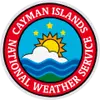

Northeast at 5 to 10 knots with higher gusts.
Moderate with a wave height of 3 to 5 feet.
The first meteorological instruments were introduced in George Town, Grand Cayman in 1930’s. A cooperative arrangement with the Cuban Government to broadcast meteorological information to ships via short wave radio from a shore transmitter to the ship’s receiving station (“ship to shore radio”) – staffed by Cubans and Caymanians.
This remained the main source of meteorological data available from the Cayman Islands until the 1950’s, when the United States’ East Coast was hit by several hurricanes. To ensure better preparedness during the Hurricane Season, the US Weather Bureau set up 16 upper air stations across the Caribbean for early detection and warning. Amongst the 16 upper air stations installed in the Caribbean, a Cooperative Hurricane Upper Air Station (CHUAS) was established in the Cayman Islands and operated jointly by Cayman and the US. This installation also was important for women as it introduced Caymanian women into the STEM field of Meteorology, as most of the men were away at sea. Thus, three Caymanian women were recruited and trained to work at the station.
During the 1970’s, meteorology in the Cayman Islands changed significantly. Following an agreement at the Caribbean Meteorological Organisation (CMO), the Jamaican Meteorological Office began providing forecasts and severe-weather warning for the Cayman Islands to accommodate inter-island and international flights. Cayman saw the increase in demand for international flights, thus, with the dawn of the jet age, began the supply of aviation weather information to assist flights into and out of the Cayman Islands.
Over the next 7 years, as air traffic into the Cayman Islands continued to expand rapidly, the Cayman Islands Government via the Civil Aviation Department requested a review of meteorological operations to satisfy the safety requirements of the International Civil Aviation Organisation (ICAO) and World Meteorological Organisation (WMO). Then, in 1986s the US officially handed over the Cooperative Hurricane Upper Air Station (CHUAS) to the Civil Aviation Department.
In 1990’s, the Cayman Islands Civil Aviation Department was granted approval by the WMO to provide its own forecasts and severe weather warnings. Thus, ending two decades of reliance on Jamaica for forecast and sever weather warning service and the start of the Cayman Islands Meteorological Office, headed by the Civil Aviation Department.
It was not until 2010 that the Cayman Islands, under the National Weather Service Law, was established as a stand-alone Government Department to be known as Cayman Islands National Weather Service (CINWS).